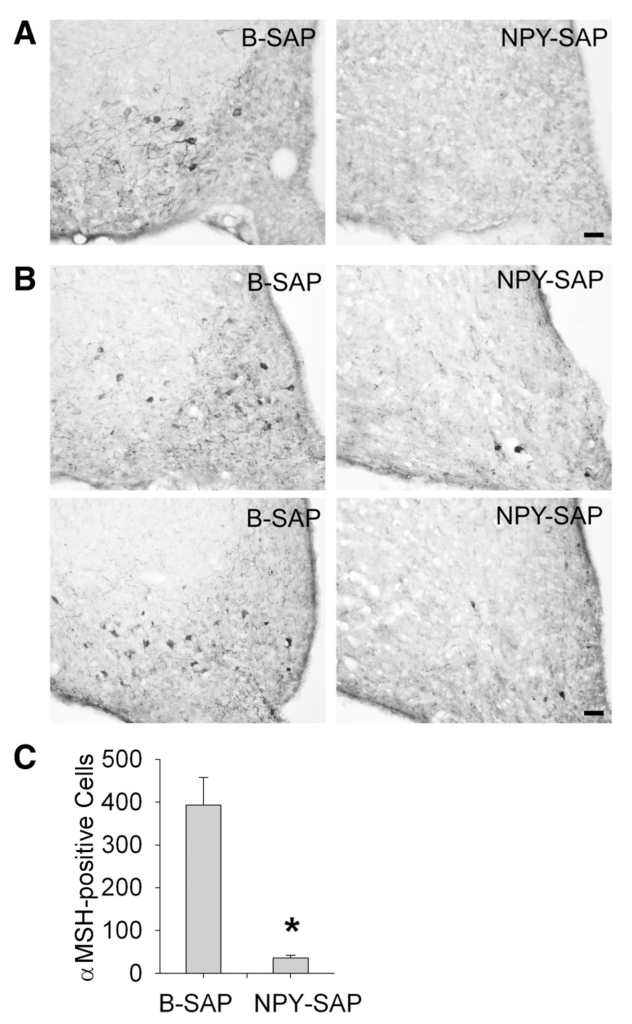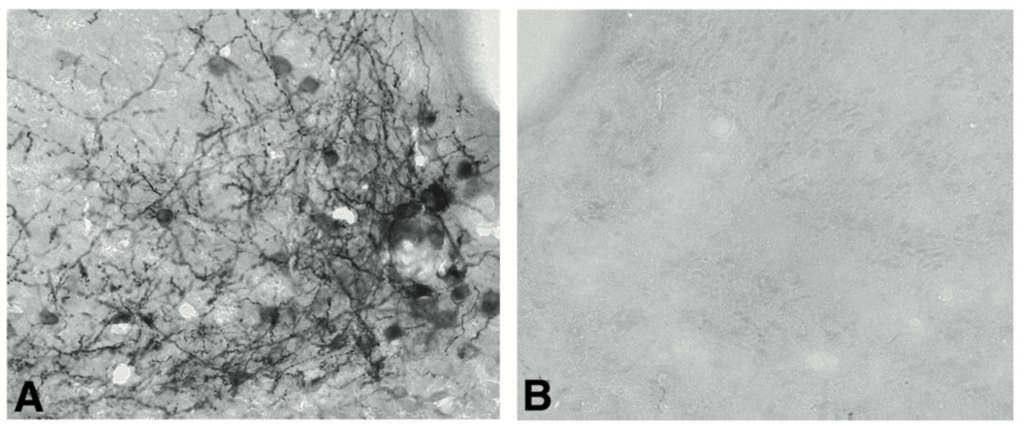Elimination of NPYR+ Neurons with NPY-Saporin : A Review of the Literature
Patrick A. Shramm, Denise Higgins, Douglas A. Lappi • Advanced Targeting Systems, Carlsbad, CA
Abstract
Introduction: NPY-SAP is a conjugate of Neuropeptide Y and the ribosome-inactivating protein (RIP) saporin. The idea behind the invention of NPY-SAP is to introduce it using the ligand’s high affinity for NPY receptors, allowing entrance of the RIP into neurons that express one of the 5 NPY receptors. The internalization of saporin causes cell death and allows for the examination of the role of the cell in physiological processes such as obesity, anxiety, itch, or pain. This technique is known as Molecular Surgery. It is specific to cells targeted (in this case, NPYR+ neurons) with no bystander effects. The cell elimination is permanent and can be used in vitro or in vivo.
Objective: To review the literature using NPY-SAP to eliminate NPYR+ neurons.
Results: NPY-SAP has been used by many researchers to determine answers to questions in their respective fields. This poster presents data generated using NPY-SAP for some of the many applications presented in the literature, from hyperphagia to pain.
Circadian integration of sleep-wake and feeding requires NPY receptor-expressing neurons in the mediobasal hypothalamus

Effects of NPY-SAP injections on NPY1R-expressing neurons in the arcuate nucleus (Arc). A) coronal brain sections showing NPY1R immunoreactivity in the Arc at 2.6 mm caudal to bregma. B) coronal brain sections showing a-melanocyte stimulating hormone (a-MSH) immunoreactivity in Arc at 2.2 (top) and 3.0 mm (bottom) caudal to bregma. C) mean number of a-MSH immunopositive cell bodies in Arc.
★P 0.001. Bar in A and B = 50 mm.
Feeding and sleep/wake states interact rhythmically across the circadian cycle. It is suspected that the mediobasal hypothalamic area (MBH) is the site where these rhythms are integrated. The authors administered bilateral 24-ng injections of NPY-SAP into the arcuate nucleus in order to eliminate NPY1R-expressing neurons in the MBH of rats. Blank-SAP was used as a control. The results indicate that these neurons are required for the interaction of feeding and sleep/wake timing.
Figure 2 from: Wiater MF, Mukherjee S, Li AJ, Dinh TT, Rooney EM, Simasko SM, Ritter S. Am J Physiol Regul Integr Comp Physiol 2011, 301:R1569- 1583.
Basomedial hypothalamic injections of neuropeptide Y conjugated to saporin selectively disrupt hypothalamic controls of food intake.
This group examined the effect of 48-ng injections of NPY-SAP into the basomedial hypothalamus (BMH) on glucoprivic feeding in rats. While there was no evidence of retrograde transport, the lesions inhibited responses to intracerebroventricular leptin and ghrelin. Neither the feeding nor the hyperglycemic response to 2-deoxy-D-glucose was affected by the lesion, indicating that these hindbrain processes do not utilize neurons in the BMH. This work also describes dosing and injection parameter studies for the use of NPY-SAP.


Coronal sections showing tyrosine hydroxylase-ir in the ventrolateral medullary catecholamine cell column ventral to the area postrema in rats injected into the arcuate nucleus with Blank-SAP control or NPY-SAP. Nearly all cells in this area co-express NPY and project to the hypothalamus.
Figures 2 and 4 from: Bugarith K, Dinh TT, Li AJ, Speth RC, Ritter S. In Targeting Trends, vol. 7(4). San Diego, CA: Advanced Targeting Systems.
Facilitation of neuropathic pain by the NPY Y1 receptor-expressing subpopulation of excitatory interneurons in the dorsal horn.
This group’s neuroanatomical and behavioral characterization of NPY1R-expressing excitatory interneurons provides compelling evidence for the development of spinally-directed NPY1R agonists to reduce chronic neuropathic pain. NPY1R-expressing interneurons were eliminated while sparing the central terminals of primary afferents.

NPY-SAP lesion selectively reduces Y1R-ir in the dorsal horn. Immunostaining in the dorsal horn of naïve rats 14 days after intrathecal injection of 1000 ng of (A) Blank-SAP or (B) NPY- SAP. (C) NPY-SAP decreased Y1R in the dorsal horn as compared to control. Values are expressed as integrated density of staining in dorsal horn. ★ P < 0.05 compared to control. Data represent mean ± SEM. Scale bars: 100 μm.
Figure 3 from: Nelson TS, Fu W, Donahue RR, Corder GF, Hokfelt T, Wiley RG, Taylor BK. Sci Rep 2019, 9:7248.

Advanced Targeting Systems’ technology – Molecular Surgery – is a modification of one of the most widely used techniques in the neurosciences: lesioning of a region by surgical means and observation of the effect.
Saporin has no way of entering a cell on its own, except by bulk-phase endocytosis. To be effective, Saporin is bound to a Targeting Agent. A Targeting Agent binds to the cell surface and is internalized. (Examples include: antibody, peptide, ligand, cytokine, growth factor, aptamer, etc.) When the conjugate is internalized it escapes the endosomal compartment and inactivates the ribosomes. This shuts down protein synthesis and results in cell death.
Journal Publications Using NPY-SAP
- Bugarith K, Dinh TT, Li AJ, Speth RC, Ritter S (2005) Basomedial hypothalamic injections of neuropeptide Y conjugated to saporin selectively disrupt hypothalamic controls of food intake. Endocrinology 146(3):1179-1191. doi: 10.1210/en.2004-1166 PMID: 15604214
- Dailey MJ, Bartness TJ (2010) Arcuate nucleus destruction does not block food deprivation-induced increases in food foraging and hoarding. Brain Res 1323:94-108. doi: 10.1016/j.brainres.2010.01.078 PMID: 20138163
- Li AJ, Dinh TT, Ritter S (2008) Hyperphagia and obesity produced by arcuate injection of NPY-saporin do not require upregulation of lateral hypothalamic orexigenic peptide genes. Peptides 29(10):1732-1739. doi: 10.1016/j.peptides.2008.05.026 PMID: 18577407
- Lyons AM, Thiele TE (2010) Neuropeptide Y conjugated to saporin alters anxiety-like behavior when injected into the central nucleus of the amygdala or basomedial hypothalamus in BALB/cJ mice. Peptides 31(12):2193-2199. doi: 10.1016/j.peptides.2010.09.009 PMID: 20863864
- Nelson TS, Fu W, Donahue RR, Corder GF, Hökfelt T, Wiley RG, Taylor BK (2019) Facilitation of neuropathic pain by the NPY Y1 receptor-expressing subpopulation of excitatory interneurons in the dorsal horn. Sci Rep 9(1):7248. doi: 10.1038/s41598-019-43493-z PMID: 31076578
- Nelson TS, Taylor BK (2021) Targeting spinal neuropeptide Y1 receptor-expressing interneurons to alleviate chronic pain and itch. Prog Neurobiol 196:101894. doi: 10.1016/j.pneurobio.2020.101894 PMID: 32777329
- Souza-Silva E, Stein T, Mascarin LZ, Dornelles FN, Bicca MA, Tonussi CR (2020) Intra-articular injection of 2-pyridylethylamine produces spinal NPY-mediated antinociception in the formalin-induced rat knee-joint pain model. Brain Res 1735:146757. doi: 10.1016/j.brainres.2020.146757 PMID: 32135147
- Wiater MF, Mukherjee S, Li AJ, Dinh TT, Rooney EM, Simasko SM, Ritter S (2011) Circadian integration of sleep-wake and feeding requires NPY receptor-expressing neurons in the mediobasal hypothalamus. Am J Physiol Regul Integr Comp Physiol 301(5):R1569-R1583. doi: 10.1152/ajpregu.00168.2011 PMID: 21880863
- Wiley RG, Lemons LL, Kline IV RH (2009) Neuropeptide Y receptor-expressing dorsal horn neurons: role in nocifensive reflex responses to heat and formalin. Neuroscience 161:139-147. doi: 10.1016/j.neuroscience.2008.12.017 PMID: 19138726
Society for Neuroscience Posters Using NPY-SAP
- Bugarith K, Ritter S, Dinh T: Hyperphagia and obesity results from the injection of the immunotoxin neuropeptide Y (NPY)-saporin (NPY-sap) into the paraventricular hypothalamus (PVH) of rats. In Society for Neuroscience. San Diego, CA: Neuroscience; 2001.
- Bugarith K, Ritter S, Dinh T: Injection of the targeted-toxin, neuropeptide Y-saporin (NPY-SAP), into the basomedial hypothalamus (BMH) disrupts leptin and ghrelin signaling. In Society for Neuroscience. San Diego, CA: Neuroscience; 2004.
- Kline IR, Lemons L, Wiley R: Antinociceptive effects of lumbar intrathecal neuropeptide y-saporin. In Society for Neuroscience. San Diego, CA: Neuroscience; 2007.
- Konsman J, Chaskiel L, Bristow A, Dantzer R: Interleukin-1 receptor-expressing cells in the arcuate hypothalamus mediate peripheral interleukin-1-induced hypophagia. In Society for Neuroscience. Washington, DC: Neuroscience; 2014.
- Lemons L, Chatterjee K, Wiley R: Neuropeptide receptor co-expression in superficial dorsal horn: Effects of galanin-saporin, neuropeptide y-saporin and dermorphin-saporin. In Society for Neuroscience. San Diego, CA: Neuroscience; 2010.
- Li A-J, Dinh T, Ritter S: Destruction of NPY receptor expressing neurons in the arcuate nucleus causes obesity and hyperphagia without increasing lateral hypothalamic orexigenic peptide gene expression. In Society for Neuroscience. San Diego, CA: Neuroscience; 2007.
- Li A-J, Wang Q, Dinh T, Ritter S: Leptin-saporin injection into the arcuate nucleus lesions NPY/AGRP and POMC neurons and produces hyperphagia, obesity and changes in diurnal feeding patterns in rats. In Society for Neuroscience. Chicago, IL: Neuroscience; 2009.
- Mack S, Wu M, Xu G: Chemoresponsiveness of the hypothalamic paraventricular nucleus (PVN) is influenced by neuropeptide Y. In Society for Neuroscience. Washington, DC: Neuroscience; 2008.
- Sparrow A, Lowery E, Thiele T: Amygdalar neuropeptide Y (NPY) signaling modulates stress- induced reductions of food intake in Balb/cJ mice. In Society for Neuroscience. San Diego, CA: Neuroscience; 2007.
- Wiater M, Mukherjee S, Dinh T, Rooney E, Li A-J, Simasko S, Ritter S: The arcuate nucleus of the hypothalamus controls the circadian distribution of sleep and feeding. In Society for Neuroscience. San Diego, CA: Neuroscience; 2007.
- Wiley R, Kline IR, Lappi D: Intrathecal galanin-saporin and NPY-saporin reduce nocifensive responses to noxious heat and formalin. In Society for Neuroscience. San Diego, CA: Neuroscience; 2004.
- Wiley R, Moore S, Kline IV RH: Analysis of inhibitory phase of formalin test: Effects of specific neural lesions. In Society for Neuroscience. Washington, DC: Neuroscience; 2008.
Conclusion
- NPY-SAP provides a specific lesioning tool for scientists to use in the investigation and discovery of how certain behaviors or afflictions are influenced by NPYR+ neurons.
- NPY-SAP has been administered in various regions of the brain and spinal cord.
- NPY-SAP is an important tool to research various disorders including obesity, pain, anxiety, and itch.
- The continued use and research with NPY-SAP and other saporin conjugates will lead to improved understanding of biological mechanisms and could offer treatment options for various NPY-related maladies.
Disclosure: Advanced Targeting Systems produces and sells saporin conjugates.

